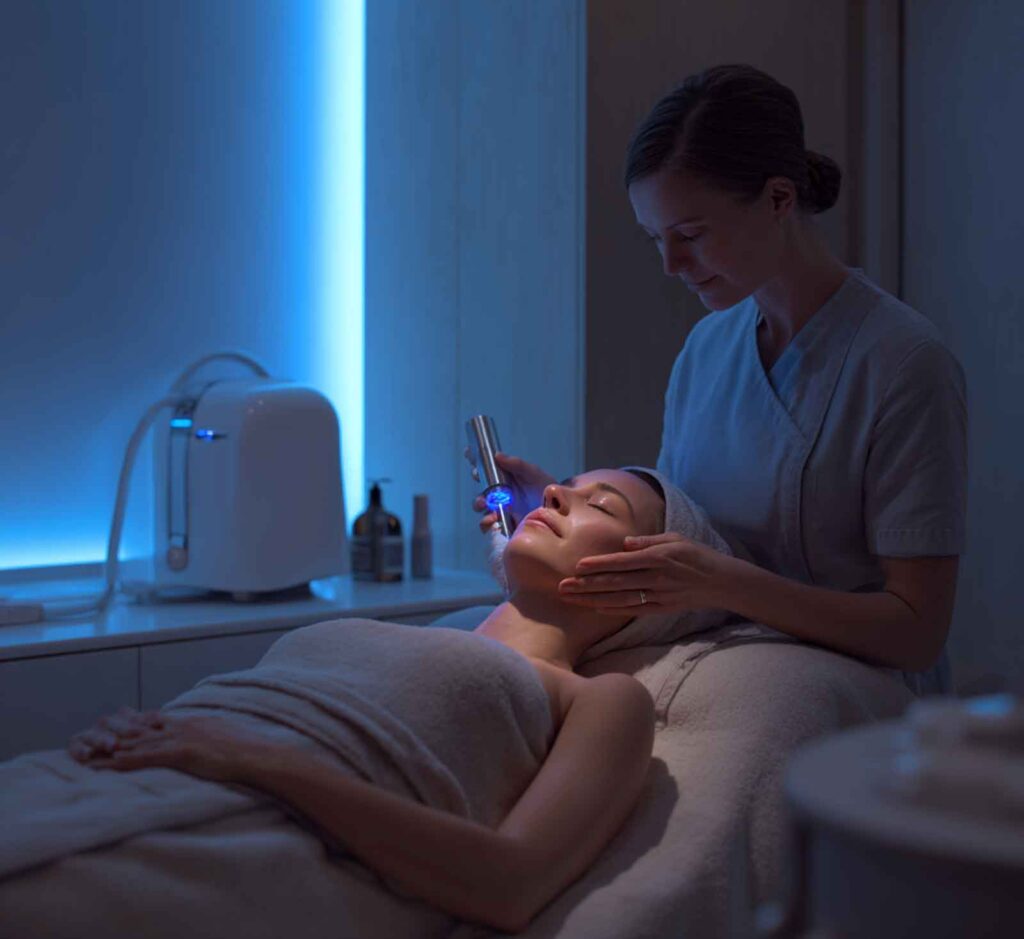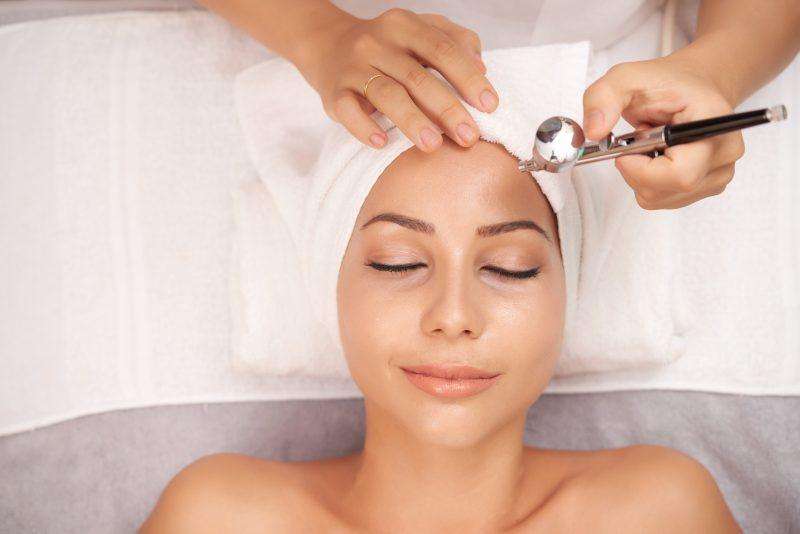Estheticians, Professional Skincare, Salon Biz, Skincare
From High-Tech Facials to Holistic Healing: Inside the Latest U.S. Day Spa Trends
The day spa experience in the United States is undergoing a transformation, blending cutting-edge technology with time-honored wellness practices. Spas are investing in advanced equipment and innovative treatments to meet a growing demand for results-driven services without sacrificing relaxation. According to recent industry research, U.S. spa industry revenue climbed to a record $21.3 billion in 2023, reflecting strong consumer appetite for new spa experiences. From high-tech facial protocols and novel exfoliation methods to non-invasive rejuvenation devices and holistic wellness enhancements, today’s day spas are redefining their service menus. In the sections that follow, the latest trends driving these changes are examined, along with their influence on the spa landscape.
Advanced Facial Protocols: Technology Meets Personalization
Modern facial treatments at day spas have evolved far beyond the classic cleanse-tone-moisturize routine. In an effort to deliver visible skin improvements, estheticians are adopting advanced facial protocols that combine multiple technologies and are tailored to each client’s needs. Personalization is paramount – therapists begin by assessing the client’s skin concerns, then design multi-step facials using a mix of techniques and products. For example, a single session might include enzyme exfoliation, hydrodermabrasion, LED light therapy, and a mild chemical peel, all sequenced strategically to maximize results. By layering modalities, spas can address issues like dullness, fine lines, and congestion in one comprehensive treatment.
One notable trend is the emphasis on being gentler yet more effective. Industry experts note that today’s corrective facials focus on building skin health without causing excessive irritation. “The peels of 2024 are much more sophisticated and much more gentle” compared to those of past decades. Rather than applying the strongest peels possible, estheticians now opt for formulations that rejuvenate with minimal inflammation, protecting the skin’s barrier. This reflects a broader “less is more” philosophy: gradually improving skin condition through a series of moderate treatments instead of a single harsh procedure.
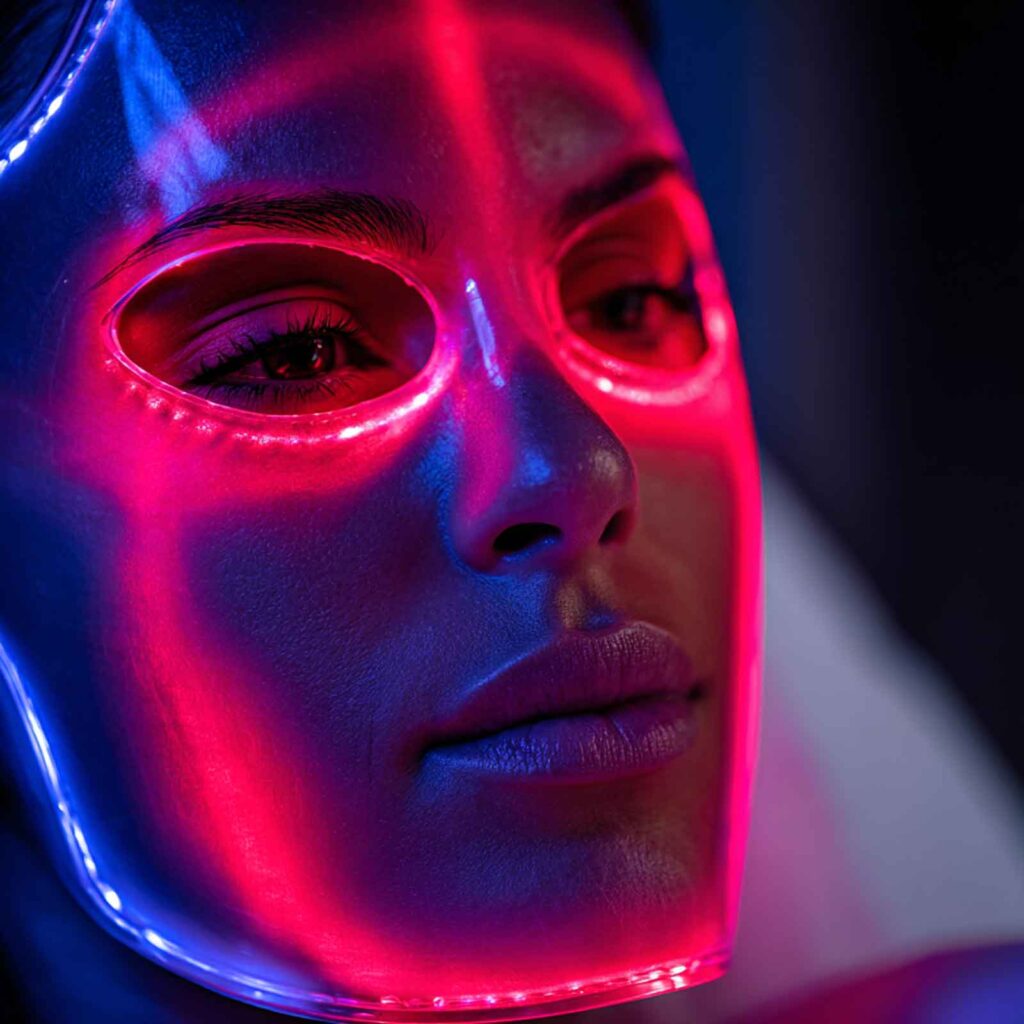
The integration of high-tech tools is also defining advanced facials. Many day spas now incorporate devices once found only in dermatologist offices. Microcurrent facial devices, for instance, deliver low-level electrical currents to tone facial muscles and lift contours. LED light therapy has become a staple as well, with estheticians using different light wavelengths to target specific concerns. Red LED light is used to stimulate collagen production and reduce wrinkles, while blue LED light kills acne-causing bacteria and calms inflammation. These technologies are non-invasive and painless, making them attractive additions to traditional facials. Additionally, some forward-thinking spas are experimenting with bio-innovations in their facials – for example, incorporating regenerative serums containing stem cell extracts or exosomes (cell-derived growth factors) to accelerate skin repair. Such cutting-edge touches blur the line between spa and clinical skincare.
Perhaps the clearest sign of advanced facials going mainstream is the popularity of specialty treatments like lymphatic drainage facials. These facials use targeted massage and sometimes suction devices to stimulate lymph flow in the face, reducing puffiness and detoxifying the skin. Over the past year, interest in lymphatic facials has surged – reports show an 83% increase in popularity for this treatment, as clients seek the de-puffing glow it provides. This statistic underscores a shift in consumer expectations: spa-goers now want facials that not only feel pampering but also deliver tangible health and beauty benefits.
Crucially, day spas are tailoring these advanced protocols to individual clients, making the experience highly customized. Many spas conduct in-depth consultations or even use skin analysis apps and AI-driven tools to craft personalized facial “blueprints.” This hyper-personalization ensures that a client concerned with hyperpigmentation, for example, gets a different combination of peels and light therapy than someone focusing on laxity or breakouts. It’s a far cry from the one-size-fits-all facials of the past. By combining personalization with technology, day spas can achieve near-clinical outcomes while still providing a relaxing, spa-like atmosphere.
Cutting-Edge Exfoliation Methods for Radiant Skin
At the heart of many facial and body treatments lies exfoliation – the removal of dead skin cells to reveal fresh skin beneath. This fundamental step has seen its own wave of innovation in day spas. Traditional exfoliation methods like scrubs and basic microdermabrasion have been upgraded or joined by new techniques that are gentler on the skin while delivering enhanced results.
One of the standout developments is hydro-dermabrasion (hydradermabrasion), a modern twist on microdermabrasion. Hydro-dermabrasion devices use a stream of water combined with vacuum suction and serums to exfoliate the skin, rather than the old method of blasting abrasive crystals. The result is a simultaneously exfoliating and hydrating treatment. The technique “combines the exfoliating power of microdermabrasion with the hydrating benefits of a facial,” using a specialized machine to slough off dead cells while infusing nourishing serums. Because it continually hydrates as it exfoliates, hydro-dermabrasion is safe for a wider range of skin types – even sensitive skin – and leaves the complexion radiant and refreshed. This technology, often branded in services like the popular hydro-infusion facials, has quickly become a spa staple for tackling fine lines, uneven texture, and clogged pores in a single step.
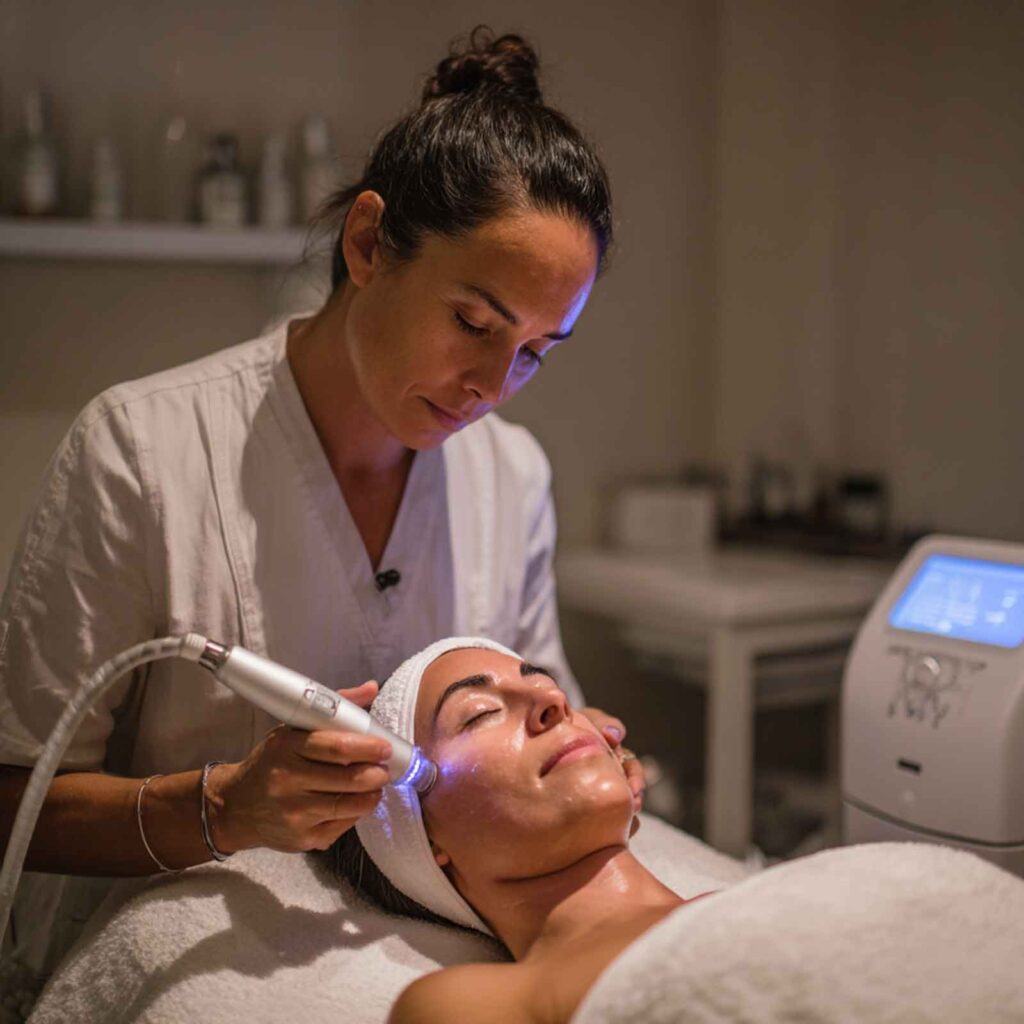
Chemical exfoliation has also advanced. Chemical peels remain a cornerstone of spa skincare, but the formulas and philosophies behind them have evolved. Whereas decades ago, stronger acid peels were favored (sometimes leaving clients peeling for days), now the trend is toward milder, smarter peels that can be repeated with little downtime. Peels using acids like lactic, mandelic, or fruit enzymes gently dissolve dull surface skin without aggressive burning. Meanwhile, dermaplaning – gently scraping off dead cells and peach fuzz with a fine blade – has become a mainstream spa offering for instantly smoother, brighter skin. In professional circles, this evolution is celebrated as the “peel evolution” – moving away from causing inflammation for short-term gains and instead encouraging the skin’s natural renewal more gradually. Some of the latest peels even incorporate advanced ingredients such as growth factors or stem cell extracts to aid recovery and rejuvenation during the peeling process. By making peels more sophisticated and focusing on maintaining a healthy skin barrier, spas can offer exfoliation that delivers a glow with minimal irritation.
Beyond the face, full-body exfoliation treatments have gained traction as people seek head-to-toe rejuvenation. Body scrubs – once simple mixtures of salt or sugar and oil – are now being enhanced with premium ingredients like coffee grounds, charcoal, or herbal infusions to address specific concerns (cellulite, detoxification, etc.). More notably, chemical peels for the body have emerged from the medical realm into day spas. Spas are offering targeted peels for areas like the back (to combat acne) or hands (to diminish sunspots), and even delicate areas like the underarms or bikini line to brighten pigmentation. As one industry report observed, peels “are for all parts of the body, not just the face,” with innovative protocols such as intimate-area peels combined with hydrodermabrasion making waves in the spa world. By extending advanced exfoliation beyond the face, day spas are catering to clients who want even skin tone and smoothness everywhere, not just on their face.
Non-Invasive Rejuvenation Devices Redefining Spa Treatments
Day spas have increasingly become high-tech hubs, filled with devices that promise to rejuvenate skin and body – all without surgery or needles. These non-invasive rejuvenation devices are transforming what a typical spa service looks like. Clients can now undergo treatments that visibly tighten, smooth, or revitalize the skin using advanced machines, yet still relax in a spa environment rather than a clinic. This trend caters to a growing group of spa-goers who want results-oriented treatments but prefer to avoid more invasive medical procedures.
One of the most widespread devices in spas today is LED light therapy, not just in facials but as stand-alone sessions or add-ons. Spas often have dedicated LED panels or full-face masks where clients bask in light for a set time. The appeal of LED is its versatility and gentle nature – different wavelengths address different issues (red for anti-aging, blue for acne, near-infrared for healing), and there’s no pain or downtime. Given its effectiveness and ease, it’s no surprise that more spas are “offering LED [and other technologies like] microcurrent, cryotherapy, and infrared treatments” as standard menu items. Clients are drawn to these innovations because they can see improvements in skin firmness, tone, or even pain relief over a series of sessions, all while enjoying a spa ambiance.
Another device-driven treatment making waves is radiofrequency (RF) skin tightening. These machines emit radio waves that safely heat the deeper layers of skin, stimulating collagen remodeling. In practical terms, an esthetician moves an RF wand over areas like the cheeks or jawline (or even the abdomen for body toning) to induce a firming effect. Traditionally found in medical spas, RF is now popping up in day spas as manufacturers develop user-friendly versions. The treatment is entirely non-invasive – clients feel a warming sensation but no significant discomfort. Over multiple sessions, RF can help reduce mild skin laxity and wrinkles, offering a subtle lift without injections or surgery. Its presence in day spas marks a convergence of beauty and technology: guests can get a skin-tightening session alongside their massage or facial, broadening what a day spa can do.
In the realm of wellness and recovery, devices like infrared saunas and cryotherapy chambers have become star attractions at upscale day spas. Infrared sauna pods use infrared light to heat the body directly, providing a detoxifying sweat at lower temperatures than traditional saunas. Users tout benefits from muscle relaxation to improved circulation and skin clarity. On the opposite end of the spectrum, cryotherapy exposes the body to subzero temperatures for a few minutes in a specialized chamber, aiming to reduce inflammation and invigorate the client. What was once a niche athlete-oriented treatment can now be found at spas where clients step out of a cryotherapy session and straight into a soothing massage. By offering such cutting-edge therapies, day spas position themselves at the intersection of beauty, wellness, and fitness recovery, attracting a broader clientele.
Another innovative category is “touchless” spa therapy, which has gained prominence in recent years. These involve high-tech equipment that delivers therapeutic benefits without a therapist’s hands. For example, some spas have vibroacoustic therapy beds – tables that use sound wave vibrations to massage the body and calm the mind. Others feature dry floatation beds or meditation pods where guests can experience weightlessness or guided meditation in a controlled environment. These technologies cater to clients seeking solitude or who are wary of close contact, while still providing relaxation. As one trend report noted, touchless treatments that use sound vibrations can offer deep relaxation “without the need for a therapist’s touch”. In a post-pandemic world, having such options has been a win-win: spas can serve more people at once (freeing up therapists) and clients who prefer minimal contact still get a healing experience.
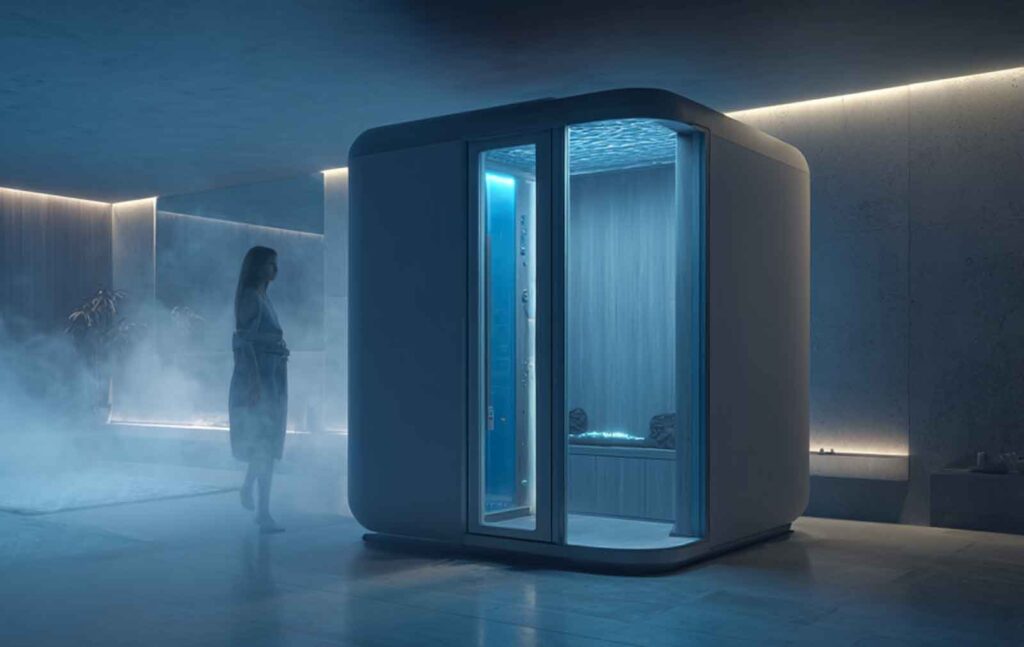
A spa client steps into a cryotherapy chamber, a non-invasive device that uses extreme cold to reduce inflammation and stimulate rejuvenation. Such high-tech wellness equipment is increasingly offered alongside traditional spa services.
Holistic Wellness Enhancements in Day Spas
Amid all the high-tech upgrades, day spas are also embracing holistic wellness enhancements that nurture the mind and spirit, not just the body. In fact, one of the defining spa trends of the moment is the fusion of classic relaxation therapies with multisensory and energy healing modalities. Spas are broadening their menus to include treatments that address emotional and mental well-being, recognizing that many clients now seek a whole-body rejuvenation experience.
Sound therapy and vibrational healing are prime examples. It’s increasingly common to find spa treatment rooms outfitted with singing bowls, chimes, or immersive sound systems. During or after a massage or facial, clients might be treated to a sound bath – enveloped in resonant tones from crystal bowls or gongs that promote deep meditative relaxation. Some spas even host dedicated sound-bath sessions for groups, tapping into the trend of social wellness gatherings. The science behind it is that sound frequencies can shift brainwaves into calmer states, and anecdotally spa guests report profound stress relief from these sessions. As a result, sound healing has moved from the fringes into mainstream spa offerings. Industry watchers note that holistic modalities like sound baths, guided meditation, and Reiki energy therapy “are gaining popularity as people seek alternative approaches to health and wellness”. In practice, a spa may offer a “mindfulness massage” where the massage is paired with ambient soundscapes and breathwork guidance, marrying physical relaxation with mental tranquility.
Reiki, an energy healing practice, is another holistic service popping up in day spas across the country. In a Reiki session, a practitioner uses light touch or hovers hands above the client’s body to balance their energy fields, intending to reduce stress and promote healing. General day spas have started to offer Reiki as either a standalone service or an add-on to traditional treatments. Clients often describe feeling a soothing warmth or tingling during Reiki and leave with a sense of emotional calm. While it’s a distinctly different approach than, say, a technical anti-aging facial, Reiki’s inclusion in spa menus signals a recognition that wellness is multifaceted. It’s also a low-risk, non-invasive service that complements the more technology-driven treatments – after an intense high-tech facial, a gentle Reiki session can help the client re-center.
Aromatherapy has long been part of spa tradition, but now it’s being incorporated in more intentional ways as part of this holistic trend. Spas are curating custom oil blends to support specific moods or benefits – for instance, an energizing citrus-ginger aroma for a morning treatment or a lavender-sandalwood blend to deepen relaxation during an evening massage. These scents are diffused in rooms, added to massage oils, or even given to clients as an inhalation to begin services with a mindful breathing ritual. The goal is to engage multiple senses – not just touch and sight but also smell and sound – to create a truly immersive experience that goes beyond the physical results. This multisensory wellness approach effectively turns a simple spa visit into a therapeutic retreat for the nervous system. As one spa trend article quipped, “sounds, lights, music, aromatherapy… it’s the wellness trend of using alternative, holistic modalities to enhance existing treatments”. In other words, spas are layering these elements over massages, facials, or body treatments to elevate them into experiences that address mental wellness.
An energy therapy session in progress: the practitioner’s hands hover to deliver Reiki healing. Many day spas now offer holistic enhancements like Reiki, sound baths, and meditation, giving clients a mind-body wellness boost alongside traditional services.
Importantly, the push toward holistic offerings is also shaping the service landscape of spas. Treatments that once might have been considered “extras” are now core parts of spa menus. Spa directors report that adding wellness modalities has helped differentiate their businesses and foster client loyalty. A guest who comes in for a skin treatment might be intrigued to try a meditation class or a healing add-on, increasing their engagement with the spa. This diversification – spanning high-tech skin treatments to mindfulness sessions – aligns with a general cultural trend: people are more proactive about mental health and stress management, and they appreciate when their local spa doubles as a wellness center. As a result, day spas are increasingly branding themselves not just as beauty service providers, but as holistic wellness destinations.

FAQ
Q: What are some examples of high-tech treatments now offered in day spas?
A: Many day spas have introduced technologies like LED light therapy, which uses specific light wavelengths to boost collagen or treat acne, and microcurrent facials, which use low electrical currents to tone facial muscles for a lifting effect. Some spas also offer radiofrequency skin tightening to firm the skin, infrared sauna sessions for detoxification, and even cryotherapy chambers for quick whole-body rejuvenation. These treatments are popular because they are non-invasive and can enhance results when combined with traditional spa services.
Q: How have facial treatments become more advanced compared to a decade ago?
A: Contemporary facials often involve multiple steps and cutting-edge products. Unlike the basic cleanse-exfoliate-mask routine of the past, an advanced facial might include gentle chemical peels, device-based exfoliation like hydrodermabrasion, and add-ons such as LED therapy or oxygen infusion. Estheticians now customize facials to each client’s skin needs, sometimes using digital skin analysis to guide the treatment plan. The products used are more sophisticated too, featuring ingredients like peptides, antioxidants, and even stem cell extracts or exosomes for skin regeneration. All these advancements mean facials today can achieve clearer, brighter, and younger-looking skin with minimal irritation or downtime.
Q: What new exfoliation methods are trending in spas?
A: Beyond classic scrubs and microdermabrasion, spas are embracing hydro-dermabrasion, which exfoliates while infusing hydration, making it gentle enough for most skin types. Enzyme peels (using natural fruit enzymes) are popular for dissolving dead skin without the harshness of strong acids. Dermaplaning, where a fine blade is used to remove dead skin and peach fuzz, has also become common for an instant smooth glow. Additionally, spas are offering more body exfoliation treatments – for example, chemical peels for the back, hands, or even bikini area – so clients can get head-to-toe skin rejuvenation. The overall trend is toward exfoliation methods that polish the skin effectively but comfortably, with little to no recovery time.
Q: How are day spas incorporating holistic wellness into their services?
A: Day spas are adding a variety of holistic therapies to complement traditional treatments. Common examples include sound healing sessions (using gongs or singing bowls to promote deep relaxation), guided meditation or breathwork classes, and Reiki energy healing for stress reduction and emotional balance. Aromatherapy is used more deliberately now, with custom essential oil blends chosen to match the client’s mood or wellness goals. Some spas have even created quiet meditation lounges or offer yoga classes as part of the spa experience. The idea is to treat the whole person – mind, body, and spirit – so a spa visit can be as restorative mentally as it is physically.
Q: Do these new high-tech and holistic treatments require special practitioners or medical supervision?
A: Generally, non-invasive spa treatments are performed by licensed spa professionals (such as estheticians or massage therapists) who have been trained on the specific device or modality. High-tech skincare equipment like LED panels, microcurrent machines, and hydrodermabrasion units are designed for use by trained estheticians and do not require a doctor on site. However, certain medical spa procedures – for instance, laser resurfacing, deep chemical peels, or injectables (e.g. Botox and fillers) – do require medical supervision and are typically only offered if the spa has a physician or nurse practitioner involved. The trends discussed here (LED, microcurrent, sound therapy, etc.) are all non-invasive and within the scope of practice for day spa personnel. Reputable spas ensure their staff is properly certified for any new technology or treatment they introduce, so clients can feel confident and safe experiencing these innovations.


